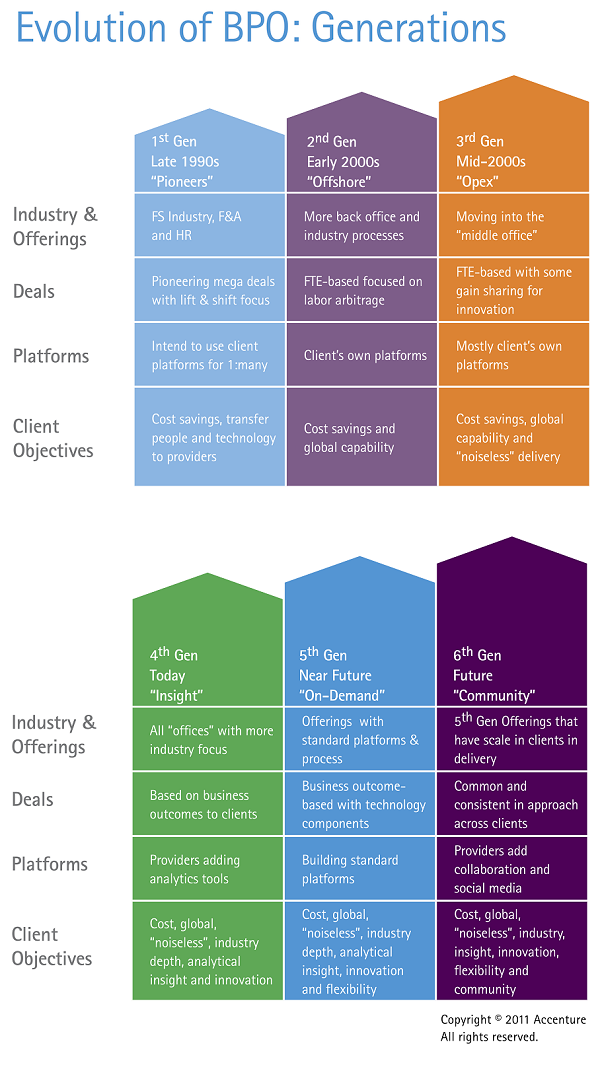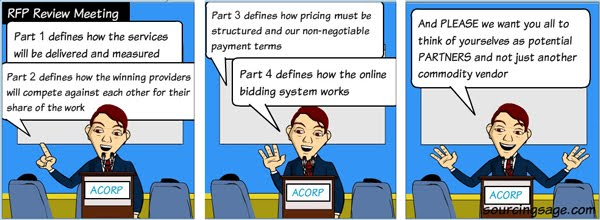If you enjoyed our recent interview with Mike Salvino, you better get that Twitter following cranked up asap…
Posted in : Absolutely Meaningless Comedy, Business Process Outsourcing (BPO), Social Networking, Sourcing Best Practises
If you enjoyed our recent interview with Mike Salvino, you better get that Twitter following cranked up asap…
Posted in : Absolutely Meaningless Comedy, Business Process Outsourcing (BPO), Social Networking, Sourcing Best Practises
Click here to listen to Friday’s excellent web-discussion involving HfS Research’s own (and definitely not SOPA-rific) Jim Slaby and Terametric’s tera-fic Chris Selland.
And for those of you who can’t be bothered, here were the main points of note:

* SOPA/PIPA have worthy anti-piracy goals, but are highly problematic in technological, political, legal, and commercial terms. They would shift considerable cost and liability for policing copyright-infringing websites and links onto businesses that aren’t engaged in piracy.
* SOPA/PIPA reflect the media & entertainment industry’s latest effort to assert control over the Internet as a content distribution channel. This is fundamentally at odds with how consumers and businesses now use it, and would crimp many valuable, legitimate commercial uses of the Internet, not just piracy.
* The many objections to SOPA/PIPA demand a smarter, more technologically-savvy, less one-sided approach to fighting piracy than this onerous legislative one. Better enforcement of existing copyright laws and pursuit of new entertainment-industry revenue models were among the panel’s suggestions.
Posted in : Security and Risk
 So if the lovely SOPA legislation gets passed, here’s what would happen to HfS:
So if the lovely SOPA legislation gets passed, here’s what would happen to HfS:
So, without further ado, here’s our security analyst, Jim Slaby, explaining why this legislation is akin to cracking a walnut with a sledgehammer…
If you were surprised to find Wikipedia offline yesterday, you weren’t alone: many Internet users were unaware of the widespread one-day online protest against SOPA and PIPA, two bills before the US Congress designed to fight online media piracy. Participation ranged from outright shutdown to the display of prominent protest messages or symbols. High-profile players included Wikipedia, Craigslist, Google, and many media sites, but thousands of other less-trafficked sites also participated.
What got them up in arms? The Stop Online Piracy Act (SOPA, the US House of Representatives’ version of the bill) and the Protect IP Act (PIPA, the US Senate version) are aimed at curbing online piracy of movies, TV programming, music, and other copyrighted content. Largely written by lobbyists for the RIAA, the MPAA, professional sports organizations and media conglomerates (Sony, ESPN, et. al.), its aim is laudable: ensuring that the artists that create original content, broadcasts of professional sporting events, and the companies that distribute them get paid for their work. We at HfS Research feel the sting of piracy ourselves — at least intellectual piracy, judging from some of our competitor’s eerily familiar-sounding reports – but it’s obvious to us that SOPA and PIPA are going about the problem all wrong.
Critics call the implementation of the legislation grossly heavy-handed: it gives the Justice Department the authority to order a blackout (using Internet domain-name filtering) not only of any website accused of hosting copyrighted content without authorization, but worse: any site that links to such a site. With nothing more than a letter of complaint, copyright holders could force payment networks (like Visa and Paypal) to block payments to such sites. If your corporate website has a blog or discussion forum that accepts comments, a link posted by a user in a comment could offend copyright holders.
To quote The Daily Show’s hilarious illustration of the problem, your site could be shut down for some commenter on one of your blogs linking to a YouTube clip of you dancing in footie pajamas to a Beyoncé song while a rerun of the Bob Newhart Show plays mutely in the background on your TV. (Incidentally, the copyright violation would be the Newhart clip.)
Viewing it in terms of the Constitutional protections of due process and free speech, it’s a disaster: it effectively reverses the hallowed American legal precept of “innocent until proven guilty”. The possibilities for rampant abuse are chilling, as it grants the Feds with virtually unchecked censorship powers. But let’s look at it purely as a commercial proposition. Your corporate website could remain blacked out for extended periods while you fight a copyright suit in court. You’d have to scrutinize every comment posted on every blog or online forum or discussion board on any or your websites to scrub potentially offending links.
For buyers of outsourcing services, you’d have to start renegotiating for contractual protections to ensure that your provider does nothing to get the websites they’re running on your behalf blocked, too. You would have to assume the burden of proof, and all the costs of doing so, to demonstrate that nothing on your websites, and no website any of them even link to, infringe on any legitimate copyright.

James R. Slaby is Research Director, Sourcing Security and Risk Strategies, HfS Research (click for bio)
HfS Research is all for the protection of copyright holders: we gladly pay for our movies, music, and on-demand reruns of The Wire and Deadwood. And we hope our subscribers aren’t giving pirated copies of our reports to their friends. (Come on: we give you tons of great content for free already!) But in essence, this boils down to an issue of digital rights management (DRM), and in the marketplace, that’s a thorny one. Even Apple, with perhaps more power to move the consumer market toward standards than any other vendor – it effectively killed Flash, forcing Adobe to move to HTML 5 – largely threw in the towel on traditional DRM a few years ago.
In the interest of zealously protecting the interests of copyright holders, SOPA and PIPA trample due process, and in turn place far too much of the economic burden for their enforcement on the vast majority of Internet-connected businesses that don’t engage in piracy. Smarter people than our elected officials in Congress, few of whom seem to have a clue about the workings of the “series of tubes” that is the Internet, need to go back to the drawing board on this problem.
And if you want to hear Jim live discussing the SOPA issues on your business, click here.
Jim Slaby (pictured) is Research Director, Sourcing Security & Risk Strategies. You can view his bio here.
Posted in : Business Process Outsourcing (BPO), IT Outsourcing / IT Services, Security and Risk, Sourcing Best Practises
“We did our BPO deal in 2005 and now we’re reaching our 7 year-itch”, confided a client governance executive last week. “Essentially, it’s operational – it works – but we’re now trying to focus on the what next. How can we find new value and new ways to tie our BPO operation to our company’s growth and renew the enthusiasm and passion of our staff?”. No single sentence has reinforced how far the BPO has come – from tales of woe and messy delivery in the mid 2000’s – to clients today complaining they’re getting bored?
The BPO industry has been going through such a remarkable evolution since the first major deals were cast barely more than a decade ago, that it’s high time we took stock and considered the phases – or generations – through which our industry has progressed.
And there are few people who have lived and breathed these generational shifts more closely that Accenture’s BPO leader, Mike Salvino (or “Sal” to those who know him). Having begun his career with Accenture’s ITO business in the late 80’s and 90’s, Mike spent time on the BPO front lines with one of the industry’s first pureplay BPO providers, Exult, before leading the HRO sales organization post their merger with HR services giant Hewitt. Mike rejoined Accenture in 2006 where he led their F&A business before taking full responsibility for the company’s entire BPO function.
We managed to grab a few moments with Sal to discuss these generational shifts in the BPO industry before he had to run off to coach his kid’s basketball team…
PHIL FERSHT: Mike, when we spoke two years ago, our discussion focused on what you termed third generation BPO, which is a vernacular many others in the industry are now using. But I know your thinking and Accenture’s delivery model, has evolved quite a bit since then and you’re now talking about fourth, fifth and even a sixth generation. Please talk us through this evolution and these new and upcoming generations of BPO.
MIKE SALVINO: Third generation BPO, where some of the providers and their clients are a bit stuck, was focused on global delivery of end-to-end processes using either operational excellence or Six Sigma-type techniques on those processes to achieve what I call “silent running.” For the most part, providers can now do third generation BPO, but it’s a very commodity-based business, it’s very price competitive, and very competitive in terms of differentiating yourself as a provider.
So we set out to define what we at Accenture call fourth generation BPO, which is focused on business outcomes, either helping a client increase its revenue or further decrease its costs. To do this, we applied analytics to all the transactions we were processing in our global delivery network. And by looking at the past to try and predict the future and showing real-world examples to our clients, we were able drive tangible business value. Very few providers are delivering fourth generation BPO.
The fifth generation, which Accenture is into right now, is taking the investments we’ve made in the cloud, in analytics, in social media and in mobility and applying them to BPO to build business platforms. Our best example is what we call our Accenture BPO Navigator, which is built in private clouds and allows our clients not only to see the end-to-end service level performance but also the business results and the business outcomes we’re driving for them on a regular basis. Access to the BPO Navigator is also enabled for mobile devices so they can carry it around with them…it makes a big impact in terms of how they are managing their businesses.
But the whole overarching concept around fifth generation BPO is creating a more flexible and scalable delivery model so our clients can really do what for 10 years they’ve been asking for – to start small and scale fast.
Sixth generation is creating learning communities of clients around these fifth generation business platforms using social media technology to create a force for future innovation and a glue between those clients and providers.
If you look at the colored columns in this graphic, you’ll get a solid idea of our perspective on each of the generations:
 PHIL: Mike, my read on this is that you have clients that have been doing this for a very long time, where you’ve been able to help them evolve along this path as they’ve become more mature, more in control, and have more visibility into how they want to perfect their processes. Do you feel the experienced adopters are going to be the first ones to progress to these fourth, fifth and sixth generations, or do you think there are going to be a lot of clients – new to BPO adoption – coming into play?
PHIL: Mike, my read on this is that you have clients that have been doing this for a very long time, where you’ve been able to help them evolve along this path as they’ve become more mature, more in control, and have more visibility into how they want to perfect their processes. Do you feel the experienced adopters are going to be the first ones to progress to these fourth, fifth and sixth generations, or do you think there are going to be a lot of clients – new to BPO adoption – coming into play?
MIKE: I think it’ll be a combination of the two. Our existing book of business is the most intuitive group to move directly into fourth generation in terms of business outcomes because they’ve seen us process their transactions for years and they’re asking the same questions we asked when we developed the concept for the fourth generation BPO…what can you tell us about our business, given that you process our transactions every year?
The new clients want to move into it more quickly. I haven’t spoken with a new client that doesn’t want to try to start small, scale fast, and use the latest and greatest technology, whether regionally or globally.
The sixth generation is a very new concept where we invite people into those communities to do business, exchange insights and to further advance the standardized platforms and processes that actually do the work. And while the fourth and fifth generations are realities today, the sixth generation is what we’re shaping now.
PHIL: Our new research has shown that, for eighty percent of today’s buyers (see link), standardizing on best practice process flows is now one of their major BPO drivers. So in terms of that, how are you building your future business around this willingness to standardize more and adopt these “pre-packaged” best practices?
MIKE: So that’s where we partner with our management consulting and with technology experts. You’re exactly right. We’ve seen this movie before in terms of people saying that there’s a product out there that’s all of a sudden going to standardize everything. Are there better products out there? Absolutely. Are people more willing to go to them? Absolutely. Our strategy is clear. We want to own those platforms, especially for the industry-specific areas. We will take our clients to platforms, much like we have taken them into our centers to do the work. The reality is that the platform discussion is no different than the debate we had five years ago about whether service providers do the work at the client’s site or can actually take the work into their own delivery centers.
So now that the work is in our centers, we can get them to a standard platform, but that’s old-type thinking. What I think is different is that once we get them to those platforms, we can we get them to fourth and fifth generation BPO by looking at the transactions. We use our management consulting talent and industry knowledge to determine what those transactions mean, and then be as flexible as we possibly can to enable our clients to start small and scale fast.
PHIL: This takes me back to the ‘90s when companies were pushing ‘buy this suite of enterprise resource software and you’d have best-in-class processes across all these domains, and we ended up with a situation where companies were buying full-scope licenses for products like SAP, but struggled to standardize their processes to conform with the ERP. Isn’t this happening all over again, where buyers are being sold some type of “productized” workflow, however this time the onus has shifted to the providers to take them through the transformation? Doesn’t this emphasize the need for buyers to rely heavily on their providers’ consultative transformation capabilities, as opposed to solely this kind of just low-cost, productized approach?
MIKE: Okay, but if we delivered exactly what you just said, that isn’t good enough. That’s just third-generation BPO. As I said earlier, most of what we’re talking about is industry specific because I don’t believe that clients are going to come off SAP or Oracle for the horizontals. So if all we do is take you to a standard process globally based on a new application, all that does is get you to third generation, with lower cost and more efficient end-to-end processes.
But today, when you sell to the C-suite, they don’t care that we process invoices, port telephone numbers or support wellness programs better than anybody else. What they really want is what the analytics data tells us about how we can have a better impact on their business either by increasing their revenue or further decreasing their costs.
I’m not positive you have to go to a new platform. But I am positive that you have to understand what you’re processing and how that’s going to impact your clients’ business.
PHIL: This is interesting, when we look at how the ITO industry developed – it kind of got stuck in its own version of “third generation” for a very long time, and arguably, a lot of it still is. But I think there’s a much bigger opportunity in BPO, because of the level of depth and intimacy you have with the clients, and their institutional process that you have to learn over time to help them move to outcome-based delivery situations. So I do think that BPO is more uniquely positioned to move buyers towards these fifth and sixth generations than some of the other outsourcing models in the past.
MIKE: But don’t you think that’s what people wanted out of BPO when we started this? It’s just taken us 10 years longer than we thought. The significant difference between ITO and BPO is that we could finally get into the business. I know it started with taking transactions that weren’t core, and by the time we got to third generation we were certainly doing non-core. But now, with fourth, fifth and sixth generation BPO, we can finally give the industry what it’s been asking for years. Do you agree?
PHIL: Yes, I think the clients have got a lot smarter over the last couple of years, and they are demanding much more innovation from their relationships. They’re also realizing they’re more accountable and until they play out the agenda, it’s going to get tough for them. So I do think that the industry has really moved on in terms of the conversation, in terms of what it’s looking to achieve. In fact, we’ve done more in the last two years than the last ten, and these current economic conditions are driving people to look more long term at their businesses, and really try to be a bit more radical with making some changes to their businesses that need to be made.
Additionally, the competitive dynamics are at a point where I think we’re already seeing three or four players break from the rest of the pack quite aggressively now, and I think in a year’s time we’ll really start to see a mature market. So I do feel that this sixth generation you’re talking about is going to happen sooner than we think. I think it’s already creeping in. Our research clearly demonstrates decision-makers are increasingly going to each other – we’ve got the data to show it. Peer experience is more impactful now than anything else, so I do feel the quicker we can get people to the community concept, giving them the ability to share best practices, worst practices, ideas and get better at this, the better off the industry will be.
MIKE: Again, the purple column on the chart that represents sixth generation BPO is what people have been asking for over the years. We used to call them user groups. We still do an event every year, and bring our clients together because they want to talk to each other about what’s going on, about what they’re dealing with, about how they’re resolving issues, whether old or new. So to be able to set up that community in an invited, exclusive-type way where you can really conduct business will be key.
PHIL: We’re in an interesting age where there seems to be a follow-the-leader scenario going on where someone comes up with a great concept and before you know it, everybody else has jumped on it. And with this concept of “generations” that you initially developed, I remember us going through it a while back and we started seeing competitors of yours coming up with similar messages and stories. What goes on in your mind when you see this …and how are you going to win?
MIKE: I love the fact that the industry has taken on the generations vernacular, as it’s the best form of flattery. And when the industry wins, Accenture BPO wins, and if we’re moving the industry into the fourth, fifth and sixth generation BPO, then clients, as a whole, will expect more from us and we’ll deliver more value. So it’s a win for clients too.
PHIL: Mike – thanks for taking the time to discuss your BPO Generations with our readers – we appreciate it, and look forward to sharing your insights.
Mike Salvino (pictured above) is Group Chief Executive, Business Process Outsourcing, for Accenture. You can read his bio here.
Posted in : Business Process Outsourcing (BPO), Finance and Accounting, HR Outsourcing, IT Outsourcing / IT Services, kpo-analytics, Outsourcing Heros, Procurement and Supply Chain, SaaS, PaaS, IaaS and BPaaS, Sourcing Best Practises, sourcing-change
Thanks to our friend Matt Heffron of Sourcing Sage for sending us another classic
Posted in : Absolutely Meaningless Comedy, Business Process Outsourcing (BPO), IT Outsourcing / IT Services

Would you kindly stay on the line to complete a brief customer satisfaction survey?
The main feature of 2011 was all about the demise of quick cost reduction as prime driver behind global sourcing, and the focus on enterprises establishing a flexible global operational framework that can be effective in today’s environment.
Yes, cost prudence is always an ongoing concern, but it’s no longer the differentiator; today it’s embedded in all forms of operation strategy and planning. Hence, this means enterprises’ prime focus is fast becoming global and not solely about being low-cost. This also means providers need to service their clients as global partners with global delivery capability.
To this end, HfS Research Fellow and Sourcing Change protagonist Deborah Kops completes her investigation into the dominance of India in the world of outsourcing, and whether or not the game’s up for non-Indian providers to come back into the picture. Over to you, Debs…
You don’t have to be Indian to be a global outsourcing provider!
In The Sourcing Raj Part I, I ticked off the reasons why non-Indian providers have had a hard time cracking the offshore outsourcing market. Indian players not only have a good 10 years’ head start penetrating the market, a brand that makes India and outsourcing virtually synonymous, and an unparalleled onshore network of buyers and influencers that all know the secret handshake. But the good news for non-Indian providers is that the global economic map will continue to evolve, making it imperative to implement a portfolio approach in response to changes in markets, availability of talent, cost and other considerations. Those players with the stomach to check nationalism at their borders and follow a few simple rules can nip at the feet of the Sourcing Raj.
You may not be familiar with the iconic 1970’s ad featuring a Native American in full regalia eating a sandwich on dark bread. The tagline, “You don’t have to be Jewish to love Levy’s,” did more to get Americans to eat something other than squishy packaged white bread than giving out samples in bakeries. Non-Indian providers have a legitimate role to play in global delivery, but it means they must approach the market differently. The market has evolved since the first Indian firms came onshore, requiring a different approach to an industry where offshore is frankly synonymous with India. It’s up to the others to convince the market that it’s possible to be a viable provider without a home base in India.
Brand as a global, not a (name that country) provider. Take a page out of the book of several leading Indian providers. They no longer call themselves Indian; they proudly declare they are global players. They push very hard to emphasize their network of operations in a range of geographies, of which India is just one. Their mission statements no longer contain the aspiration to be India’s number one (or two or three). They focus their messaging where their clients are, at the same time paying sufficient attention in their home markets to build enough brand to attract the right talent.
Yet many offshore players doggedly play their country card in their branding. While having pride in the home office location is important, understanding that parochialism is the enemy of globalization is critical to getting on a revenue growth trajectory. Clients seek good delivery from markets with sufficient scale, talent and reputation to underwrite their decisions, and that perform as strong cogs in a global delivery model. At the end of the day, that’s what matters. Providers that shed the trappings of their legacy location have a good chance to grow and prosper.
Rapidly devolve management control. To be honest, it has taken the Indian firms far too long to realize that true globalization is more than locating cheeks in seats in other geographies, retaining tight control in India. Even today, look up some of the Indian majors and note that every key management position is occupied by someone in Gurgaon, Chennai, Mumbai or Bangalore. Many Indian providers talk the global talk, but often when it comes to making a decision, it requires a call to country code 91.
Non-Indian providers have an opportunity to send the right globalization message now, leapfrogging the Indian providers by quickly devolving control into exporting markets. Clients increasingly look for leadership across geographies, signifying that the company’s management is truly global, evaluating the provider on the extent to which there is local decision making authority. Take a page out of the books of the global majors such as Accenture or IBM—locate key execs with real decision making authority in a range of geographies. It’s the smart way to grow a business in a global world.
Move quickly to develop a strong base of local sales and account management staff. For years, Indian providers parachuted in sales and account management staff, thinking they were saving money, or even believing that local hires were incapable of understanding and selling the offshore value proposition. However, the industry now “gets” offshore; there is increasing recognition that one no longer had to grow up in India to sell or manage clients.
The non-Indian player should aggressively seize the “glocal” high ground, declaring we’re both global and local by hiring prodigious indigenous talent. Clients still prefer to do business with people they believe are fundamentally like them so putting a local face on the client interface goes a long way in establishing credibility.
Declare your hand. The market’s far too mature and competitive to entertain provider neophytes who are continuously and publicly testing the market. The market looks for providers who can draw a line in the sand, saying what they can do, why they can do it, and for whom they have already delivered results. Do your homework, pick your service offerings and industries, and settle on an approach before you blitz the market. Trying to be all things to all people is a recipe for disappointment.
Invest in marketing. Jobs exporting markets cannot be conquered with a website that says little, an exhibit booth staffed by a smiling young lady, a thumb drive with a logo, or an occasional banner ad in a third tier industry publication. Assuming because you as a provider are the best in Wroclaw or Wuxi that the market will beat a path to your door is massively misguided. Sitting offshore and second guessing your target market is not only revenue-limiting, it’s sheer hubris. Spending marketing funds sporadically tells the market you are not serious players.
If it is not important enough to invest the right amount of money in effective marketing, why bother to enter a market? There’s a direct line of sight between spend and results—spend little, especially in the wrong areas, get nothing. Spend a lot on the wrong approaches, get little. Spend the right amount on channels that matter and it’s a game changer. Figure out the right channels, the right approaches and spend the right amount of money, and the payback can be more than 25 times investment over time.
Develop superior English language skills. It’s not enough to rely solely on state investment in English training when the provider’s future is dependent on speaking the world’s premier business language. Ensuring that everyone who interacts with the client at every level has a command of clear, contextual business English is not only an imperative and differentiator, it eliminates unspoken objections inherent in client teams. Playing the non-language dependent card no longer works.
The Bottom-line: many non-Indian providers have the opportunity, but have a lot of work to do
Can non-Indian outsourcing providers end the sourcing raj? Certainly geopolitics, the state of the global economy, currency movements and, more specifically, the positioning of the IT/ITES industry within India will affect the course of events. And it will take some time before the Chinese or Brazilian equivalent of the sourcing network becomes as insidious as that of the Indians. But much of the answer lies within the direct control of the non-Indian players. Will they play a global game? Will they place a bet on a few services, and make the requisite investment? Will their nationals start to appear on the rosters of client teams? Will they devolve management to other geographies? Will they spend the amount of money necessary to create a brand? Will they invest in training superior English speaking capability? Only time will tell.
Posted in : Business Process Outsourcing (BPO), IT Outsourcing / IT Services, Sourcing Best Practises, Sourcing Locations, sourcing-change

A special thanks to Sutherland’s Matthew Heffron for sending us this little ditty. Check out his excellent BPO video blog Sourcing Sage.
Posted in : Absolutely Meaningless Comedy, Business Process Outsourcing (BPO), Sourcing Best Practises
One of the highlights of 2011 was that great web-debate on the Future of BPO where 1,100 people across the globe dialed in to hear from our buy and sell families. Like any typical extended family at Thanksgiving, they cussed and discussed about the trends and challenges buffeting BPO. They passed the peas and offered some pretty unbridled opinion and insight. Visit the BPO Resource Center to download the highlights…
Posted in : Finance and Accounting, HR Outsourcing, kpo-analytics, Outsourcing Events, Outsourcing Heros, Procurement and Supply Chain, Sourcing Best Practises, sourcing-change
Here are some “horses” memories as a big chubby thank you for all of your support this year… Oh – and turn up the volume 🙂
Posted in : Business Process Outsourcing (BPO), horses-for-sources-company-news, IT Outsourcing / IT Services
 “Is nothing sacred anymore”, I thought, as I received my 200th holiday greetings e-card from some person I have never heard of, trying to use the opportunity to have me tell me about his company’s incredible achievements in 2011. Buddy – if you want to sell me something, or tell me how great your company is, just send me a pitch claiming you’re the best – and I may even read it. But pretending you know me and using that as the guise to get my attention, just incites me to press that delete button and not give you a second of my time.
“Is nothing sacred anymore”, I thought, as I received my 200th holiday greetings e-card from some person I have never heard of, trying to use the opportunity to have me tell me about his company’s incredible achievements in 2011. Buddy – if you want to sell me something, or tell me how great your company is, just send me a pitch claiming you’re the best – and I may even read it. But pretending you know me and using that as the guise to get my attention, just incites me to press that delete button and not give you a second of my time.
This is just one example of how social media is driving the human element out of our business interactions. There’s just too much interaction out there, too much opinion, too much self-promotion and – let’s face it – too many bloody people with seemingly nothing better to do. Come to think of it, I don’t think there has been a time in my career when I’ve known so many people who I can’t figure out what is it they actually do all day, how they make any money for themselves, or others. And I can’t figure out, for the life of me, why some companies pay some people to do what it is they supposedly do all day.
In fact, I probably spend more time avoiding people these days than trying to network with them – few seem to have anything interesting to say, any new ideas about where the world is going and simply are following the commonly agreed set of “industry trends” that most people have been force-fed by industry influencers who are running out of sexy new ideas (or ran out a while back, and are bumbling along on empty until they find something new to grab onto).
What happened to the times when peoples’ opinions mattered – even if they were wrong, or were just plain off-the-wall? Economic and political paralysis, exacerbated by inane electronic social networking has sapped so much of the passion, creativity and enthusiasm from our professional lives. I find myself increasingly spending time with people who are interested in sport, music, movies or just playing with the kids, because at least there is enthusiasm and passion there. But going out for dinners with faceless executives to talk about cloud-bloody-computing – and how it is going to change the world… without being able to explain why, just that it will, because they need to sound cloudy… don’t get me started!
What we need is a dose of renewed optimism, that our world has an exciting future, that there will be areas for renewed growth, renewed innovation, renewed opportunities. That we have exciting careers where we can constantly find new challenges and invigorating things to do. Have you ever known a time when so many people cling to the job they hate because it’s the only way they know how to make a paycheck these days, and are too nervous to even consider a new challenge? Too many people are stuck in a professional status quo – and have been since the 2008 crash scared the professional lives out of so many. I have lost count of the number of people who are just plain miserable in their jobs, have lost confidence in their management and their companies’ offerings and directions, and are losing that spark and desire to find something that will give them that renewed energy and that passion? Many people seem to be so jaded these days, and it worries me that they will struggle to ever be truly energized and passionate about what they do again.
So let’s make 2012 the year of getting passionate again! Let’s dig deep to be honest with ourselves about what gets us up in the morning – what will make us look forward to going to work again. Paralyzed politicians won’t come with the answers, and neither will directionless corporate managers – only you can summon up the courage and passion to make a difference. Take a risk – jeez, take a pay cut if you have to – but if you lose your passion for what you do, you’ll find it harder and harder each year to get it back.
Posted in : Absolutely Meaningless Comedy